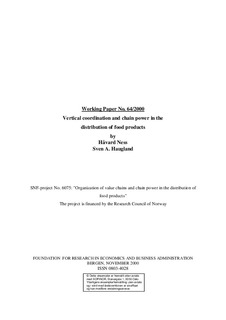| dc.description.abstract | During the last decade, the retail of consumer goods has changed dramatically in Norway and in the Nordic countries. In particular, the trade once dominated by independent merchants usually controlling small corporate entities is now dominated by large and nation-wide retail chains controlling a larger part of the value chain and the points of sale to the consumers. Thus, the chains have expanded horizontally and vertically, as they have integrated upstream and included wholesale functions. Although the chains have increased their relative power and moved the “point of interception” versus the producers one step back in the supply chain, the long term outcomes of these changes are not given as the cooperative industry still are dominant actors in the supply chain. The paper proposes a conceptual framework for understanding these changes and the potential consequences of the changed power relations. The basic framework builds on contract and negotiation theory. Next, the basic model is extended to account for power relations. The paper argues that by adopting collaborative strategies across organizational boundaries throughout the supply chain, each individual firm as well as the consumers are likely to gain from it. | en |
